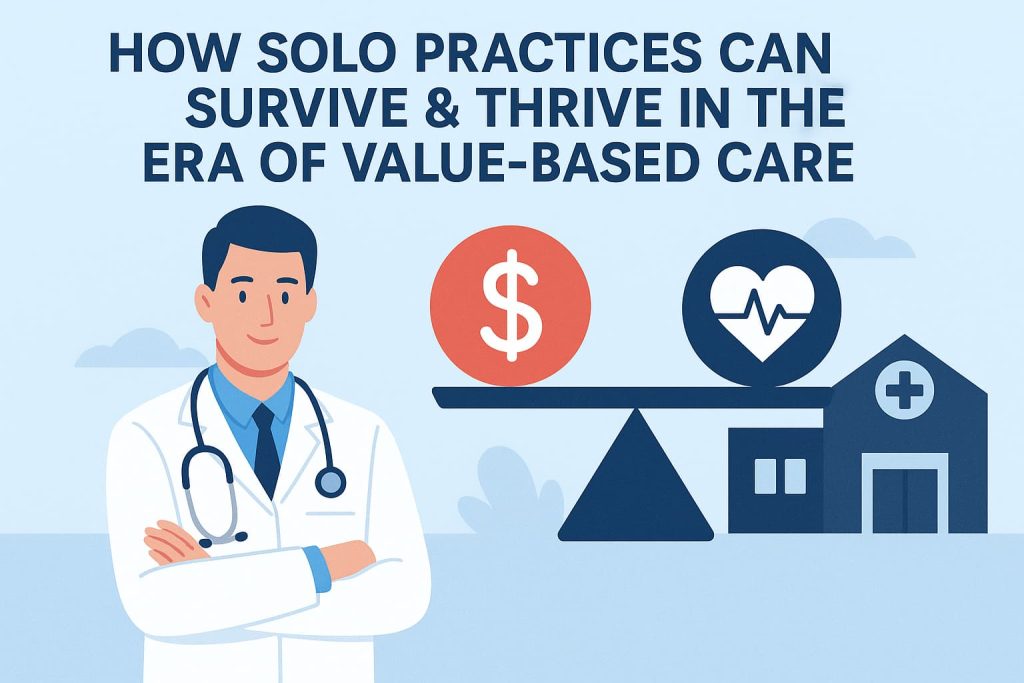Introduction: Why Solo Doctors Feel Under Siege
Across the U.S., solo and small medical practices are struggling to adapt.
For decades, the fee-for-service (FFS) model rewarded physicians for volume — the more patients seen, the higher the revenue. But today, Medicare and commercial payers are shifting rapidly toward value-based care, where reimbursement depends on patient outcomes, satisfaction, and long-term health.
For solo doctors, this shift can feel like a threat. With fewer staff, tighter budgets, and growing reporting requirements, it’s easy to feel left behind while large health systems expand.
Yet here’s the truth: solo practices are uniquely positioned to thrive. Why? Because value-based care rewards what small practices already do best: personalized care, continuity, and trust.
This guide explores how you can future-proof your practice by combining care management programs (CCM, RPM, BHI, PCM) with digital marketing strategies (SEO, websites, email, reputation management). Done right, these approaches can:
- Increase recurring monthly revenue by $100K+ annually.
- Reduce patient leakage to hospital systems.
- Strengthen your ability to succeed under value-based contracts.
What Is Value-Based Care — And Why It Matters in 2025
Value-based care is a healthcare delivery model where providers are paid for quality of care instead of quantity of services. (CMS Innovation Center)
Key Highlights:
- 70% of U.S. hospitals and 55% of physician practices now participate in some form of value-based care (CMS, 2024).
- By 2030, CMS projects that all Medicare patients will be covered by value-based models.
- Practices that fail to adopt care management and outcome tracking risk losing patients — and revenue.
For solo practices, adapting is no longer optional. Patients, insurers, and regulators are aligned: outcomes matter more than visits.
Healthcare Marketing for Doctors and Medical Practices
Fee-for-Service vs. Value-Based Care: What’s at Stake
Fee-for-Service (FFS):
- Paid per visit, test, or procedure.
- Rewards volume, not quality.
- Leaves physicians vulnerable to declining reimbursements.
Value-Based Care (VBC):
- Paid based on patient outcomes, reduced hospitalizations, and satisfaction.
- Encourages preventive care and chronic condition management.
- Provides stability through recurring reimbursements (e.g., CCM, RPM).
Stat: A 2023 Deloitte study found that practices using value-based care saw 25% higher patient retention rates and 12% higher net revenue per patient compared to FFS-only clinics.
For solo practices, this means one thing: adapting early gives you a competitive advantage.
Digital Marketing: The Growth Engine for Solo Practices
In the era of value-based care, digital visibility = survival. Patients no longer rely on word-of-mouth alone — they Google you first. If they can’t find you, they’ll find someone else.
SEO for Doctors
- 77% of patients search online before booking an appointment (Google Health, 2023).
- Local SEO helps your practice show up in searches like “primary care doctor near me” or “chronic care management doctor.”
- With the right strategy, solo doctors can outrank hospital groups in local searches.
Internal link: [SEO for Doctors: How to Rank Higher and Attract More Patients]
Healthcare Website Design
- Your website is your digital front door.
- Needs to be HIPAA-compliant, mobile-friendly, and conversion-optimized.
- Must include:
- Online scheduling
- Patient education (blogs, care program pages)
- Clear calls-to-action (CTA) for CCM, RPM, BHI, PCM enrollment
- Online scheduling
Internal link: [Healthcare Website Design: Proven Strategies to Attract & Convert More Patients]
Reputation Management for Doctors
- 74% of patients will not book with a doctor who has fewer than 4 stars online (Healthgrades).
- Google Business Profile and Healthgrades optimization are critical.
- Responding professionally to reviews builds trust and demonstrates transparency.
Internal link: [Reputation Management for Doctors: How to Build Trust and Attract More Patients]
Care Management Programs: The Financial Backbone of Value-Based Care
Digital marketing brings patients in. But to stabilize revenue and succeed in value-based care, you must implement reimbursable programs.
Chronic Care Management (CCM)
- For patients with 2+ chronic conditions.
- Medicare reimburses $42–$126 per patient/month.
- Scales quickly: 100 CCM patients = $120,000 annually.
Remote Patient Monitoring (RPM)
- Devices (blood pressure cuffs, glucose monitors) send patient data remotely.
- Reimbursement: up to $120 per patient/month.
- Improves outcomes: Studies show RPM reduces ER visits by 20–30%.
Behavioral Health Integration (BHI)
- Supports mental health care inside primary care.
- Medicare reimbursement: ~$48/month per patient.
- Essential for holistic value-based outcomes.
Principal Care Management (PCM)
- For patients with 1 chronic condition.
- Great entry point for solo practices without resources for CCM.
- Reimbursement: ~$62/month per patient.
Stat: CMS data shows that CCM and RPM combined can add $250K+ annual recurring revenue for a solo practice managing just 200 patients.
Case Study: How One Solo Doctor Turned the Tide
Dr. Emily Martinez – Family Medicine, Arizona
Challenge:
- Declining FFS revenue, losing patients to hospital-owned urgent care.
- No digital presence, no care programs.
Solution:
- CareNova team implemented CCM + RPM.
- Redesigned website with patient portal + SEO optimization.
- Reputation management campaign on Google + Healthgrades.
Results (Year 1):
- Added $135,000 in new recurring revenue from CCM + RPM.
- Increased Google rating from 4.1 ⭐ to 4.8 ⭐.
- The patient panel grew by 30%.
Takeaway: Even a solo doctor can thrive in value-based care with the right mix of digital marketing + care management programs.
Content Marketing & Patient Engagement: Building Loyalty
Patients in value-based care expect education + engagement.
- Blogs & Articles: “How to Manage Diabetes at Home” or “Why RPM Helps Prevent ER Visits.”
- Email Campaigns: Monthly tips, reminders for check-ups, wellness resources.
- Social Media: Showcase success stories and patient education.
Stat: Practices using patient engagement emails see 40% higher CCM enrollment rates (MGMA, 2023)
Action Plan for Solo Doctors in 2025
- Audit your practice’s digital presence (SEO, reviews, website).
- Implement one care management program (start with CCM or RPM).
- Invest in content + email marketing to drive patient loyalty.
- Track quality metrics and use them in your marketing to show payers and patients your value.
Conclusion: Thriving in the Era of Value-Based Care
Solo doctors don’t need to fear value-based care. With the right strategy, you can increase revenue, improve outcomes, and compete with larger systems.
At CareNova, we help solo and small practices succeed with:
- Healthcare SEO
- Patient-friendly website design
- Reputation management
- Care management program consulting (CCM, RPM, BHI, PCM)
Ready to future-proof your practice? Book a free consultation with CareNova today — let’s build a practice that grows revenue while improving patient care.
FAQs
Q1: What is value-based care?
Value-based care is a healthcare payment model that rewards providers for patient outcomes instead of the number of visits or procedures.
Q2: How can solo practices benefit from CCM or RPM?
Both programs provide recurring monthly revenue while improving outcomes, which aligns with value-based care goals.
Q3: Is SEO important for doctors?
Yes. Without SEO, patients won’t find your practice online. Local SEO ensures your clinic ranks in searches like “primary care near me.”
Q4: How much revenue can CCM add to a solo practice?
On average, $120,000 annually for 100 patients, depending on billing compliance.
Q5: What’s the first step to transition into value-based care?
Start with a digital audit and implement at least one care management program (CCM or RPM) for stable recurring revenue.



